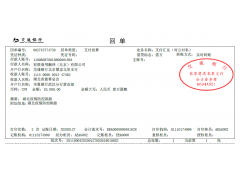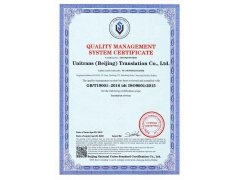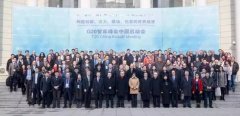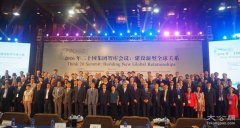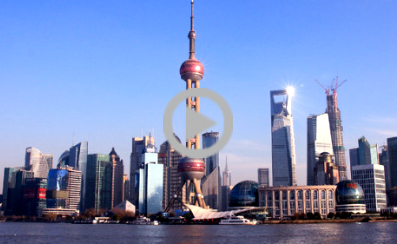- 行业新闻
-
北京翻译公司完成“大自然”介绍英文翻译
发布时间:2020-02-24 16:47 点击:
北京翻译公司完成“大自然”介绍英文翻译The region is home to about:3- 33 percent of all mammals,- 35 percent of all reptilian spe- cies,- 41 percent of all birds and- 50 per cent of all amphibians.The Amazon forest is often called ‘lungs of the world’.Much of the biodiversity is under threat due to a combination of factors: high population growth, infrastructure development and unsustainable exploitation of nat- ural resources.Latin America – Biodiver- sity Hotspot: Latin America and the Caribbean (LAC) region has the greatest biological diver- sity on the planet, having several of the world’s megadiverse countries.1 The region has over 40 percent of the Earth’s biodi- versity with more than one- quarter of its forests.2Sustainable development - the way forward: Biodiversity and the associated ecosystem services they provide are vital for human well being. At a fundamental level, they are essential for providing food, drink- ing water and purifying the air we breathe. Cognizant of the value of bio- diversity, countries in the region are strengthening governance of their nat- ural resources and promoting sustainable development.Growth of Hydropower Sec- tor: Economies in LAC are grow- ing at a rapid rate with infrastruc- ture playing a crucial role in pro- moting and sustaining this growth. Investment in infrastructure pro- jects particularly in the hydro sec- tor is growing with many such as Hidroaysen complex in Chile or1. In this paper LAC is taken to include all nations and dependencies in or immediately off the coasts of Mexico, Central and South America, as well as those in the Caribbean Sea.2. Bovarnick et al. 2010. 3 & 4. UNEP. 2010Belo Monte in Brazil either under construction or being planned (Figure 1). In the past decades there has been a proliferation of hydropower projects reaching 150 GW of installed capacity by 2010 and it is expected to grow significantly (Figure 2).5In part due to hydrological abundance, hydropower in LAC has a larger share in the energy mix than in any other region, and comparative advantages in many markets.6 In 2010, with 80% of the electricity generated coming from hydropower amounting to 84 GW in installed capacity, Brazil was second in the world just behind China (200 GW).7 In fact, as depicted in Table 1 hy- dropower fulfills a large share of the electricity produced in LAC.8 The available but unex- ploited hydropower po- tential is approximately 540 GW.11 About 65% of electricity comes from hydropower in Latin America.Table 1. Electricity produced through HydropowerShare of Hy- dropower Countries≈ 100 Paraguay> 80 % Brazil> 70 % Colombia, Costa RicaVenezuela> 60% Peru> 50% EcuadorUruguay5, 8, 10 & 11. IEA. 2012.6. Hartmann et al. 2013.7. Kumar et al. 2011.9. Hydrovision Brazil. 2014.Figure 1. Investment in Hydropower9Environment MattersA. Legal FrameworkCountries across the region have instituted formal requirements for Envi- ronmental Assessment (EA) for public and private investment projects. They have adopted a number of EA tools such as Environmental Diagnos- tic, Strategic Environmental Assessment (SEA), Initial Environmental Evaluation (IEE), Cumulative Impact Assessment (CIA), Environmental and Social Impact Assessment (ESIA), Environmental Risk Assessment (ERA), and Environmental Impact Assessment (EIA).12EIA/ESIA: It is the most widely used tool and regu- lations for some form of EIA exists in all counties. Through ESIA, anticipated impacts on the environ- ment and local communi- ties of a proposed project are assessed and measures to avoid, minimize, miti- gate and/or compensate for the impacts are provided.SEA: SEA evaluates at the strategic level, a project‘s environmental im- pacts in the context of social and economic factors. It complements and ex- tends the traditional EIA, which focuses solely on physical environmental impacts. SEAs address technological, economic, social, and institutional changes, and environmental management systems.13 It is increasingly being used in Latin America across various sectors.Licensing/Permitting Requirements: An Environmental per- mit is authorization from the competent environmental authori- ty to undertake work on a project that may be liable to cause environmental degradation of a natural resource like water, flora and fauna or alternation of the landscape etc. The permit details the obligations, requirements and conditions that the permit holder needs to fulfill in order to avoid, minimize, miti- gate and compensate for the impacts, as well as consequences The responsibility for environmental compli- ance falls on project de- velopers, who must meet EIA-related require- ments. Legislation on SEA: Chile, Dominican Re- public, Panama, Guate- mala, Colombia, and Pe- ru. In Colombia, offset plans have to be presented to the environmental agen- cies up to one year after the environmental permit has been awarded.1412. Acerbi, M, et al. 2014.13. Loayza, F. 2012.14. Sarmiento, M. 201315. Tremarctoscolombia. 2014.for not fulfilling the stated obligations.16 The permitting requirements vary between the countries. For example, in Brazil, EIAs are associated with three different environmental licenses - for pre-installation, installation, and operation.Additional legal requirements can vary between countries. In Brazil for ex- ample, project developers are required to offset their residual environmental impacts by supporting the establishment and maintenance of conservation units through a payment as part of the environmental licensing process. The compensation amount varies as a function of the intensity of undesirable effects. The money is used to create and maintain protected areas.17Monitoring: Monitoring and follow up to ensure the environmental provi- sions are being implemented is carried out. This function is often carried out by environmental agencies such as PROFEPA in Mexico, Procuradoria Ambiental in Peru and Brazilian Institute of Environment and Renewable Natural Resources (IBAMA) in Brazil. They monitor, enforce and if neces- sary impose fines and penalties for non-compliance.B. Environmental Impacts of Hydropower ProjectsThe environmental impacts of hydropower projects vary depending on the project’s type, size and sensitivity of the project site. Typical environmental impacts of hydro projects are presented in Table 2.Table 2. Typology and Potential Impacts18 Several countries have independent licensing bodies separate from the ministries of Environ- ment. For example, Agencia Nacional de Li- cenciamiento Ambiental (ANLA) in Colombia, National Service of Envi- ronmental Certification of Sustainable Invest- ments (SENACE) in Pe- ru and Servicio de Evalu- acion Ambiental (SEA) in Chile. Typically, investors are expected to bear the cost of environmental licens- ing, which includes but is not limited to the envi- ronmental studies, miti- gation and compensation measures.Hydropower Plant Type Main environmental ImpactsAll Barrier for fish migration and navigation, and sediment transport. Physical modifica- tion of riverbed and shorelines.Run of-river Unchanged river flow when powerhouse in dam toe; when localized further down- stream reduced flow between intake and powerhouse.Reservoir (storage) Alteration of natural and human environment by impoundment resulting in impacts on ecosystems and biodiversity and communities.Modification of volume and seasonal patterns of river flow, changes in water temper- ature and quality, land use change-related GHG emissionsMultipurpose As for reservoir; Possible water use conflicts; Driver for regional development.Pumped Stor- age Impacts confined to a small area, often operated outside the river basin as a separate system that only exchanges the water from a nearby river from time to time16. Mancero-Bucheli, et al. 2009.17. Darbi, et al. 2009.18. JICA 2013.The severity of impacts on natural habitats resulting from hydroelectric dams is quite diverse as shown in Table 3. While some impacts occur only during construction, the most important impacts are usually due to the long-term existence and operation of the dam and reservoir. Other signifi- cant impacts on natural habitats can result from complementary public works such as access roads, power transmission lines, and quarries and borrow pits as indicated in Table 4.19Cumulative Impacts: In addition to site-specific impacts, cumulative im- pacts can be of concern. These arise from the incremental (additive) impact of an action when added to other past, present, and reasonably foreseeable future actions. This is particularly important when damming a river at multi- ple locations.The effect of a single dam is usually studied and mitigated but lager envi- ronmental problems can occur due to the combination of several impact sources. Within a basin, the greater the number of dams, the greater the fragmentation of river ecosystems. They affect both the physical variables, such as flow regime and water quality, and the productivity and species Key impacts include changes in flow regimes and water quality, barrier to fish migration, loss of biological diversity, and population displacement. The most threatened groups of fauna in Latin America are amphibians (32% of total) and fishes (24%) and these are most likely to be affected dur- ing dam construction.Table 3. Severity of Natural Habitat Issues2019 & 20. JICA 2013composition of different rivers. The problems may be magnified as more dams are added to a river system, resulting in an increased and cumulative loss of natural resources, habitat quality, environmental sustainability andecosystem integrity.21 Cumulative impacts canTable 4. Hydropower Impacts on Natural Habitats2221. WCD. 2000.22. JICA 2013result from individually minor, but collectively significant, actions tak- ing place over a period of time within a given spa- tial scale. Cumulative Impact As- sessment analyses direct and indirect impacts caused by a dam, other dams, other projects from different sectors, and from any associated facilities.C. Climate ChangeClimate change and hydropower are inextricably linked. On one hand, cli- mate change is likely to affect river flow patterns affecting hydropower gen- eration while on the other hand hydropower is said to contribute to methane emission leading to global warming. This link indicates that hydropower and its effect on the environment need to be holistically addressed.Climate change is expected to affect regional precipitation patterns leading to changes rainfall timings, river flow volumes and seasonal flow directly af- fecting the resource potential for hydropower generation. Changes to floods and droughts pattern may increase the cost and risk for hydropower pro- jects.23 Latin America region is also vulnerable to large-scale and persistent rainfall anomalies due to El Nino and La Nina. Climate change can also af- fect sediment generation, transport processes, sediment flux in a river and sedimentation in reservoirs, due to changes in hydrological processes.At the same time, hydro power plants are known to produce carbon dioxide and methane, and in some cases can produce more of these greenhouse gases than comparable power plants running on fossil fuels. Carbon emissions vary from dam to dam. For example, it was estimated that in 1990 the greenhouse effect of emissions from the Curuá-Una dam in Pará, Brazil, was more than three-and-a-half times what would have been produced by generating the same amount of electricity from fossil fuels. This happens because the large amounts of carbon present in trees and other plants are released when the res- ervoir is initially flooded and the plants rot. A few years after the reservoir is flooded emissions peak again as the plant matter at the reservoir's bottom de- composes without oxygen, resulting in a build-up of dissolved methane. This is released into the atmosphere when water passes through the dam's tur- bines.24 As dam reservoirs can emit greenhouse gases, the Clean Development Mechanism process has screened out support for particular types of dam most likely to be prone to high emissions.25 Broadly, the larger the reservoir area per unit of electricity generated, the greater the possibility that reservoir emissions may exceed the thermal generation offset through hydroelectricity displac- ing conventional coal, gas or oil burning. 2623. Kumar et al. 2011.24. Graham-Rowe. 2005; Fearnside, 2013.25. & 26. Skinner, J and Haas, L.J. 2014.D. CompensationCompensation is any action to avoid, remedy or mitigate adverse effects of projects on a relevant area, landscape or environment. Compensatory measures are meant to primarily provide value equivalent to that which has been damaged at the same place, and secondarily provide other environ- mental value to another place. The idea is of ‘no net loss’ and/or a ‘net gain’ in biodiversity. The measure is expected to be connected with the negative impact that has been identified and the affected party ought to benefit from the compensation measure. Offset is a subset of compensation. In Colombia, develop- ment projects are re- quired to offset residual biodiversity impacts by restoring or protecting an equivalent habitat else- where. It is based on no net loss and ecological equivalence. Offset rati- os range from 1:4 to 1:10.2927. Anderson. E.P. 2013.28. Hartmann et al. 2013.29. Sarmiento, M. 2013. 30. JICA. 2013.E. Environmental FlowsAn important, and often controversial issue in hydroelectric projects, is the need for ecological flows. Environmental flow is the water that is released downstream of the dam/weir (or left in the river downstream of an off-river scheme) and not used to generate electricity. Its purpose is to maintain flow in the river for habitat, biodiversity and/or other water users.Environmental flow requirements (which include managed flood releases) are increasingly used to reduce the impacts of changed stream flow regimes on aquatic, floodplain and coastal ecosystems downstream. Depending on the design of the scheme, variable flushing flows can be discharged from the dam, left in the river (in an ‘off-river’ scheme), and/or discharged from the power house.31At Yacyretá Hydropower plant the ecological flow was calculated at 1,500 m3/s of the spillway of the Ana Cuá. This flow includes the quantity, timing, and quality of water flow required to sustain freshwater and estuarine eco- systems of the river and the human livelihoods and wellbeing that depend on these ecosystems in the project area of the Parana River. The current ecolog- ical flow is an essential mitigation processes required to support a healthy river ecosystem32 The key objective is to maintain the existing in- stream values as closely as possible. To allow for environ- mental flows, the infra- structure requires specif- ic design features and operational regimes that may impact on the effi- ciency or capacity of the scheme.Ecological flow at Yacyretá31. & 32. JICA. 2013.Overlooked Voices - Protecting Indigenous PeoplesThe term indigenous peoples covers a wide variety of social groups whose traditional livelihood, socio-economic and cultural institutions differ greatly not only from country to country, but also within countries. There are 671 indigenous peoples (IP) in LAC today, over half of whom are settled in tropi- cal forest areas. The indigenous population in LAC is around 30-50 million people speaking around 860 languages and dialects.33 See Table 5.Table 5. Distribution of Indigenous Peoples in LAC 34&35In the last two decades the indigenous peoples movement including access to rights and recognition within the socio-political process has profoundly grown. At an international level, the Convention Concerning Indigenous and Tribal Peoples in Independent Countries of the International Labour Organi- zation (ILO Convention No. 169) approved in 1989 and the United Nations Declaration on the Rights of Indigenous Peoples, approved by the Human Rights Council in 2006 lay out the minimum specific rights of the indigenous people.Article No. 3 of the Declaration states "Indigenous peoples have the right of self–determination. By virtue of that right they freely determine their political status and freely pursue their economic, social and cultural development", and a set of specific collective rights are recognized for indigenous peoples. Latin America is multi– ethnic and multicultural . Indigenous peoples are highly diverse and their socio–political status within the countries they inhabit varies widely.33. &.34. ECLAC. 2006.35. International Work Group for Indigenous Affairs. 2011.The basic international standards relating to the collective rights of indige- nous peoples may be grouped into the following categories:36(a) The right to non–discrimination;(b) The right to cultural integrity;(c) The right to own, use, control and have access to land, territories and resources;(d) The right to development and social well–being;(e) The right to political participation and to free, prior and informed con- sent.Most Latin American countries have legislation recognizing some degree of indigenous rights with guidelines for negotiation and consultation with af- fected communities. A number of countries including Bolivia, Brazil, Chile, Colombia, Costa Rica, Mexico, Peru, and Venezuela are signatories to ILO Convention 169 on Indigenous and Tribal Peoples. As Indigenous peoples have close ties to the land and natural resources, their concerns about devel- opment is often focused on land rights, security, language, spiritual links to ancestors and social or community cohesion, which they may see as critical elements for improving their quality of life. These views have sometimes caused conflicts between development proponents and indigenous peoples, as some IP still view mainstream development with suspicion or even as inappropriate.37 This in part is leading to more inclusive development ex- ploring more culturally appropriate models.Free Prior and Informed Consent (FPIC): In many counties, regulations on FPIC are in place and it is required to be carried out for investment pro- jects. It generally implies that indigenous peoples have the right to approve or By 2000, in Bolivia, Guatemala and Peru, in- digenous people repre- sented 62%, 41% and32%, respectively, of their total populations. About 48% of the indig- enous peoples population in Brazil, 64% in Mexi- co, 79% in Costa Rica and 35% in Chile reside in rural areas. IP often bear a dispro- portionate burden of the negative social, econom- ic, and environmental consequences of devel- opment, without receiv- ing commensurate bene- fits. It is important to involve IP in the Project, in iden- tifying solutions and in implementing them.36. ECLAC. 2006.37. World Bank. 2009.reject proposed projects that may affect them or their lands, territories or re- sources which is often the case with hydropower projects. Generally in- formed consultation is undertaken during project preparation to inform af- fected indigenous peoples of the proposed project, assess together with af- fected communities possible project benefits and adverse impacts, and agree on measures to enhance benefits or mitigate adverse impacts to be incorpo- rated into project design. Based on these consultations it is ascertained whether affected communities broadly support the emerging project design. The extent and methodology of the consultations are based on the project type, its possible impacts and the circumstances of affected indigenous peo- ples.38Social License to operate is another terminology often used with corporations and linked to corporate social responsibility. It is not a legal requirement. Corporations are increasingly expected not to negatively impact the environ- ment and go beyond the legal requirements. Social License to operate is the degree to which a corporation and its activities meet the expectations of local communities, the wider society, and various constituent groups.39Inclusive Development: Development objectives of projects are enhanced when indigenous peoples affected by the project participate in its prepara- tion and implementation resulting in culturally appropriate benefits, based on their needs and aspirations. One of the issues associated with hydropower projects is resettlement and/or involuntary displacement. Not all hydropower projects may require resettlement. Resettlement and/or involuntary displace- ment involves displacing and resettling people as well as restoring their live- lihoods through the rebuilding of their communities.4138. World Bank. 2009.39. Gunningham, N., et al. 2004.40. Hurwitz, Z. 2014.41. Kumar et al. 201142. Forest Peoples Programme. Undated.Role of Civil SocietyThe past decade has seen a rise in public participation with society holding government and companies accountable for their actions promoting transpar- ency and accountability. For any developmental project, particularly hydro power projects, involvement and board agreement of civil society in terms of environmental and social impacts and benefits is vital. Increasingly civil soci- ety organizations (CSO) are challenging and influencing developmental ac- tivities, halting the process in some cases, unless the project addresses the societal concerns.There are numerous CSO’s working on poverty reduction and environmental protection including some with a focus on hydropower development. They are highly diverse and can range from small organizations or advocacy groups having few staff members/volunteers to large organizations including non-governmental organizations (NGO). Many take active part in policy dia- logue around development policies having specialized knowledge and on-the-ground experience working with local communities. They raise awareness of societal issues often from the perspective of the rights of poor, marginalized or vulnerable populations. In Brazil alone there are between 300,000-350,000 NGOs involved in development.43Setting Standards - International Best PracticesAs hydropower schemes modify existing hydrological regimes, the surround- ing environment and affect local communities, sound planning, design, and management is warranted. A number of international criteria and guidelines exist to measure the sustainability of hydropower projects. Most international lending institutions like the World Bank, International Finance Corporation etc have specific safeguard requirements along with guidelines stating what makes for acceptable environmental and social performance. There is a trend to meet standards that are additional to, and higher than national standards as depicted in Table 6.44In 2000, the World Commission on Dams after intensive review published the report entitled 'Dams and Development: a new framework for decision- making', establishing comprehensive guidelines for dam building. The report describes an innovative framework for planning water and energy projects in order to protect the environment and affected people allowing for more equi- table sharing of the benefits from the dam. It laid out 7 strategic priorities that can lead to a more sustainable project: 45• Gaining public acceptance• Comprehensive options assessment• Addressing existing dams43. Tomlinson, B. and AidWatch Canada. 2013. 44 & 46. Skinner, J and Haas, L.J. 2014.45. WCD. 2000.47. Anderson, E.P. 2013. There is a growing ex- pectation that commer- cial banks, companies and corporations in- volved in hydropower should be held accounta- ble for any violations in their stated corporate social responsibility poli- cies.46 Advancement in technol- ogy has strengthened communication, making it easier to garner sup- port and voice opinions reaching a wider audi- ence than ever before. The criteria are designed to identify where the po- tential for environmental and social impacts could be so unfavorable as to undermine the electricity benefit of a hydropower project or could be ex- tremely difficult or im- possible to mitigate.47• Sustaining rivers and livelihoods• Recognizing Entitlements and Sharing Benefits• Ensuring Compliance• Sharing Rivers for Peace, Development and Security.Table 6. Typology of voluntary and mandatory standards and guidelines48Standards as conditions for international funding support for hydropower projects Voluntary standards and guidelines regional and international com- mitment to follow when adopted by parties• World Bank Safeguard Policies (E&S and Dam Safety)• OECD’s Export Credit Group Renewable Energy Agreement Guide- lines (OECD, 2005)• OECD EIA guidelines• Other IFI policies (ADB, AfDB, IADB, etc.)• EU Linking Directive (European Parliament, 2004)• Bilateral and regional carbon funds. • Equator Principles• IEA Hydropower Agreement• Regional agreements accepted by individual governments e.g. Preliminary Design• Guidance in the Mekong (MRC, 2009)• ICOLD and IEEA technical guidelines• Low-impact hydro standards.• WCD guidelines with a small ‘g’.Both mandatory (when cited in legislation) and voluntary:• WCD (Strategic Priorities and Policy Principles)• Hydropower Sustainability Assessment ProtocolBinding on all participants that seek or provide financing for projects. Generally monitored and independently verified. Binding on parties who ‘signed up’ when adopted in national systems, or by regional/ international bodies. Not necessarily independently verified.Signed international/regional conventions and agreements adopted in national laws e.g. the Mekong 1995 Agreement and supporting Procedures (MRC, 1995), the Ramsar Convention (Ramsar, 1971), and the EU Water Framework Directive (European Union, 2000).Similarly, the International Energy Association (IEA) has published guide- lines with recommendations covering areas such as energy policy frame- work, decision-making process, comparison of project alternatives, im- proved environmental management and sharing benefits with local commu- nities. In 2003, the World Bank released “Good Dams and Bad Dams: envi- ronmental criteria for site selection of hydroelectric projects. ” The report presented quantitative indicators for ranking proposed projects in terms of their likely environmental and social consequences.IHA Protocol: Broadly based on the WCD report and the IEA study and other international standards, the more recently developed International Hy- dropower Association (IHA) Hydropower Sustainability Assessment Proto- col is a comprehensive assessment tool to be used during the project’s life cycle: early stage, preparation, implementation and operation. Assessment is carried out against around 20 relevant sustainability topics, depending on the development stage of the project. Scores between 1 and 5 are assigned for each topic with the range such that 5 represents proven best practice and 3 represents basic good practice. The topics cover the three pillars of sustaina- bility – social, economic, and environmental – and include issues such as downstream flow regimes, indigenous peoples, biodiversity, infrastructure48. Skinner, J and Haas, L.J. 2014. IHA protocol provides the means to improve the sustainability of specific topics within a n individ- ual project. It is an evidence-based assessment of a project's performance, prepared by an accredited asses- sor.safety, resettlement, water quality, and erosion and sedimentation.49A number of hydropower projects globally are now applying this Protocol setting a new standard for hydropower projects.Topics covered by the IHA Protocol 5049. IEA. 2012.50. IHA. 2014.51. IHA. 2013. The Protocol is the re- sult of intensive work by a multi-stakeholder body with representatives from social and environmental NGOs, governments in- cluding China, commer- cial and development banks and the hydropow- er sector represented by IHA.To Dam or Not To DamChinese companies and investors are becoming a major player in Latin America influencing the domestic political dynamics. In many cases, with numerous developmental projects particularly in the oil, mining and hydro sectors financed by the Chinese, the investment itself and its subsequent exe- cution has become an object of contention in domestic politics over issues such as the number of Chinese workers brought in, concessions given by the government, and the environmental impact.52 Once a company is established and the project is underway, an interaction between the company the local labor force, community and the surrounding environment continues.As Hydropower development inherently involves complex set of economic, environmental, and social opportunities and risks, Chinese developers and investors have a responsibility in ensuring that projects they finance are en- vironmentally and socially sustainable. With significant negative impacts on the local communities and the environment persisting in many projects, the focus on Chinese investments is greater than ever. Chinese hydropower companies and banks are now the largest dam builders in the world. In 2012, at least 308 dam projects (mostly for hydropower generation) in 70 different countries around the world in in- volved Chinese compa- nies or financiers.The Chinese government expects Chinese companies to abide by and respect local laws. Several Chinese hy- dropower companies have also committed to using Chinese domestic standards where host country laws and standards are weaker. The adoption of the World Bank’s safeguard policies as a minimum standard regarding resettlement and environmental issues as well as incorporation of the International Financial Corporation’s Performance Standards into Sinohydro’s policy on community relations is a positive step.53 How these poli- cies are implemented will be an actual test of commitment.Domestic laws and regulations within China on social and environmental protection are well developed. De- velopers of projects with significant environmental impacts are required to conduct an EIA prior to project construction and there are opportunities for public participation throughout the EIA process by setting out procedures for disclosing EIAs to the public. At a minimum it can be expected that Chinese developers and investors should follow their domestic standard when working in other countries and should not lower their standards.54Investment in hydropower in Latin America is intensifying and sustainability is proving to be a critical com- ponent of the boom. At the end of the day, Chinese developers will not only be judged on technical grounds but also on their environmental and social performance, which can affect future investments. To maintain and strengthen their position within the hydropower sector, adopting and implementing sustainable practices is vital for Chinese developers.52. Ellis, R.E.2013.53. & 54. International Rivers. 2012.ReferencesAcerbi, M; Sánchez-Triana, E; Enríquez, S; Tiffer-Sotomayor, R; Gomes, A; Siegmann, K; Clemente- Fernandez, P; Nkrumah, Nyaneba E. 2014. Environmental Impact Assessment Systems in Latin America and the Caribbean.Anderson, E.P. 2013. Hydropower development and ecosystem services in Central America. Inter-American Develop- ment Bank. Environmental Safeguards Unit. Technical note.Bovarnick, A., Alpizar, F., and Schnell, C. (Eds). 2010. Importance of biodiversity and ecosystems in economic growth and equity in Latin America and the Caribbean: An economic valuation of ecosystems. United Nations Devel- opment Programme.Darbi, M., Ohlenburg, H., Herberg, A., Wende, W., Skambracks, D. and Herbert, M. 2009. International Approaches to Compensation for Impacts on Biological Diversity. Final Report.ECLAC. 2006. Social panorama of Latin America. Economic Commission for Latin America and the Caribbean.Ellis. R.E. 2013. The strategic dimension of Chinese engagement with Latin America. Perry paper series No. 1. Wil- liam J. Perry Center for Hemispheric Defense Studies.Fearnside, P.M. 2013. Climate change and the Amazon: Tropical dams emit greenhouse gases. ReVista, Harvard Re- view of Latin America 12(2): 30-31.Forest Peoples Programme. Undated. Free, prior and informed consent (FPIC). Available at http:// www.forestpeoples.org/guiding-principles/free-prior-and-informed-consent-fpic. Accessed 15 May 2014.Hartmann, J., Harrison, D., Opperman, J. and Gill, R. The New Frontier of Hydropower Sustainability: Planning at the System Scale. The Nature Conservancy.Hurwitz, Z. 2014. Dam standards: A rights-based approach. A Guidebook for Civil Society. International Rivers.Hydrovision Brazil. 2014. South American hydro industry. Available at http://www.powerbrasilevents.com/en/ hydrovision-brasil.html. Accessed 12 May 2014.IEA. 2012. Technology roadmap: Hydropower. International Energy Association.IHA. 2014. Hydropower Sustainability Assessment Protocol. Available at http://www.hydrosustainability.org/ Protocol.aspx. Accessed 15 May 2014.IHA. 2013. Official Assessment - Jirau Hydropower Project.ILO. 2014. Indigenous and Tribal peoples: Latin America. Available at http://www.ilo.org/indigenous/ Activitiesbyregion/LatinAmerica/lang--en/index.htm. Accessed 15 May 2014.International Rivers. 2012. The new great walls: A guide to China’s overseas dam industry.Kumar, A., Schei, T., Ahenkorah, A., Caceres Rodriguez, R., Devernay, J.-M., Freitas, M., Hall, D., Killingtveit, Å. and Liu, Z. 2011: Hydropower. In IPCC special report on renewable energy sources and climate change mitigation. InO. Edenhofer, Pichs-Madruga, R., Sokona, Y., Seyboth, K., Matschoss, P., Kadner, S., Zwickel, T., Eickemeier, P., Hansen, G., Schlomer, S., von Stechow, C. (eds). Cambridge University Press, Cambridge, United Kingdom and New York, NY, USA.International Work Group for Indigenous Affairs. 2011. Indigenous groups in Latin America. Available at http:// www.iwgia.org/regions/latin-america. Accessed 15 May 2014.JICA. 2013. Sourcebook for infrastructure projects affecting natural habitats.Loayza, F. 2012. Strategic Environmental Assessment, Guidance Notes on Tools for Pollution Management. In Gettingto Green – A Sourcebook of Pollution Management Policy Tools for Growth and Competitiveness. Washington, DC: World Bank.Gunningham, N., Kagan, R.A., and Thornton, D. 2004.Social License and Environmental Protection: Why Businesses Go Beyond Compliance. Law and Social Inquiry. American Bar Foundation.Manchero-Bucheli, G., Otero, P., Oscar Vela, B.C., Herran, C. 2009. Colombia. In Campbell, C. (ed) ‘Legal aspects of doing business in Latin America’. Yorkhill Law Publishing.Sarmiento, M. 2013.Colombia takes lead in Latin American biodiversity offsetting. Ecosystem Marketplace. A Forest rends initiative.Skinner, J and Haas, L.J. 2014. Watered down? A review of social and environmental safeguards for large dam pro- jects. Natural Resource Issues No. 28. IIED, London.Tremarctoscolombia. 2014. Introduction. Available athttp://www.tremarctoscolombia.org/introduccion.html. Accessed 26 May 2014.Tomlinson, B. and AidWatch Canada. 2013.Working with civil society in foreign aid: Possibilities for South-South cooperation? United Nations Development Programme.UNEP. 2010. State of biodiversity in Latin America and the Caribbean.World Commission on Dams. 2000. Dams and development: A new framework for decision-making. Earthscan Publi- cations Ltd.World Bank. 2009. Guidebook to the World Bank Indigenous Peoples Policy.北京翻译公司,天津翻译公司,郑州翻译公司,西安翻译公司,重庆翻译公司,长沙翻译公司,济南翻译公司,青岛翻译公司,








